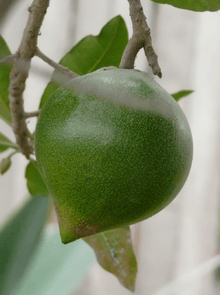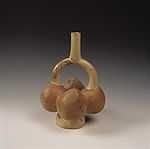Pouteria lucuma
| Lúcuma | |
|---|---|
 | |
| Scientific classification | |
| Kingdom: | Plantae |
| Clade: | Angiosperms |
| Clade: | Eudicots |
| Clade: | Asterids |
| Order: | Ericales |
| Family: | Sapotaceae |
| Genus: | Pouteria |
| Species: | P. lucuma |
| Binomial name | |
| Pouteria lucuma (Ruiz & Pav.) Kuntze | |
| Synonyms | |
| |

The lúcuma (Pouteria lucuma) is a subtropical fruit native to the Andean valleys of Chile, Ecuador, and Peru.[1] Lucuma has been found on ceramics at burial sites of the indigenous people of coastal Peru.[2] The Moche people had a fascination with agriculture and often chose to represent fruits and vegetables, including lucuma, in their art.[3]
In Peru harvesting season is from October to March and in Chile from June to November.[1]
The fruit was first seen and reported by Europeans in the Chinchasuyu region of the Inca Empire in 1531.[4] It is sometimes known as lucmo. In the Philippines it is known as teissa. It is also called "eggfruit" in English, a common name also given to the closely related canistel (Pouteria campechina). The name "eggfruit" refers to the fruits' dry flesh, which is similar in texture to a hard-boiled egg yolk. The lucuma has particularly dry flesh which possesses a unique flavor of maple and sweet potato. It is a very nutritious fruit, having high levels of carotene, vitamin B3, and other B vitamins. The round or ovoid fruits are green, with a bright yellow flesh that is often fibrous. It grows at temperate elevations, between 1,000–2,400 metres. Temperatures of its elevated native range make the species technically subtropical, even though its native region is strictly tropical. It has been grown successfully in subtropical foothills of California. Attempts at growing lucuma in Florida's climate typically fail.[5] In addition to Peru, the fruit is grown also to a limited extent in Bolivia and Costa Rica. It grows well in most tropical regions, but is not widely favored. The fruit is also available in large quantities in Laos and in Vietnam.
Taxonomy
Formerly known as Lucuma obovata, it is now considered a member of the genus Pouteria, and given the name Pouteria lucuma. It is not the species Pouteria obovata.
Uses

Due to its very dry flesh, the fruit is not commonly eaten by itself. Lucuma flavored juices, milk shakes and especially ice cream are however extremely popular throughout Peru and are enjoyed year-round by many locals and tourists. A very popular desert dish called "Merengue con Salsa de Lucuma" is served in Chile.
References
- ↑ 1.0 1.1 CAPÍTULO I: LA LÚCUMA
- ↑ Lucmo
- ↑ Berrin, Katherine & Larco Museum. The Spirit of Ancient Peru:Treasures from the Museo Arqueológico Rafael Larco Herrera. New York: Thames and Hudson, 1997.
- ↑ Lesser-known and under-utilised plant resources Ameenah Gurib-Fakim - 2005 - Page 59
- ↑ Lucuma: Superfood of the Incas